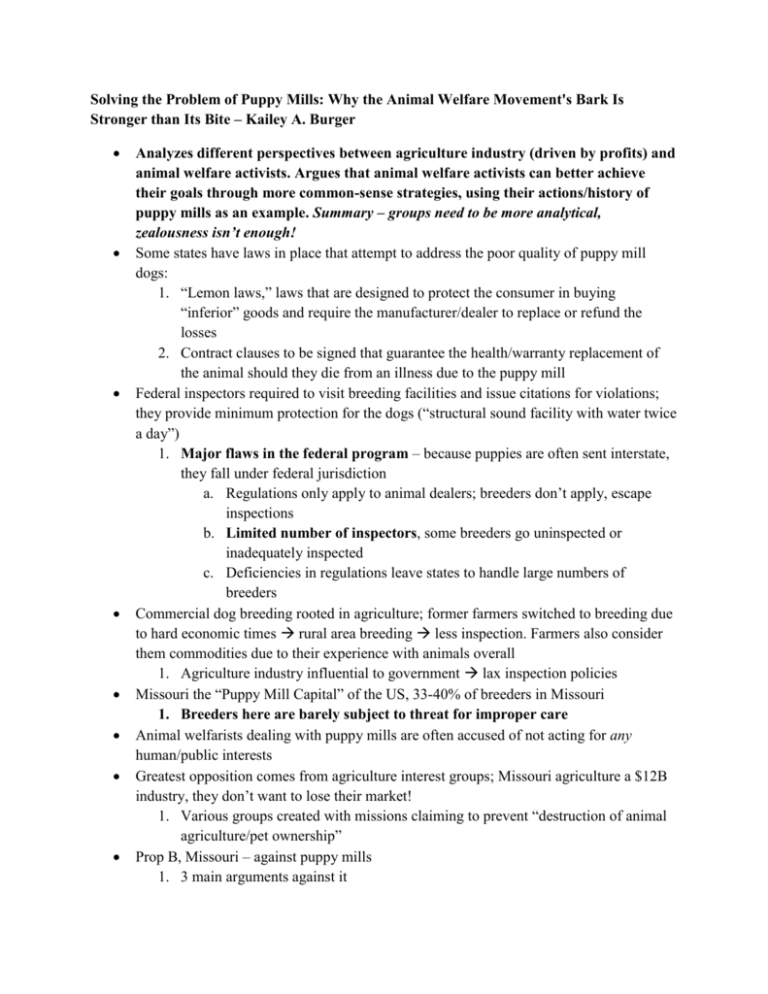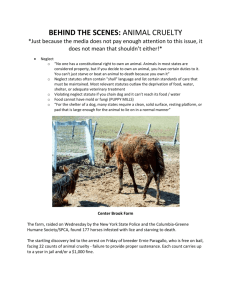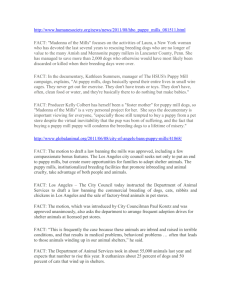File
advertisement

Solving the Problem of Puppy Mills: Why the Animal Welfare Movement's Bark Is Stronger than Its Bite – Kailey A. Burger Analyzes different perspectives between agriculture industry (driven by profits) and animal welfare activists. Argues that animal welfare activists can better achieve their goals through more common-sense strategies, using their actions/history of puppy mills as an example. Summary – groups need to be more analytical, zealousness isn’t enough! Some states have laws in place that attempt to address the poor quality of puppy mill dogs: 1. “Lemon laws,” laws that are designed to protect the consumer in buying “inferior” goods and require the manufacturer/dealer to replace or refund the losses 2. Contract clauses to be signed that guarantee the health/warranty replacement of the animal should they die from an illness due to the puppy mill Federal inspectors required to visit breeding facilities and issue citations for violations; they provide minimum protection for the dogs (“structural sound facility with water twice a day”) 1. Major flaws in the federal program – because puppies are often sent interstate, they fall under federal jurisdiction a. Regulations only apply to animal dealers; breeders don’t apply, escape inspections b. Limited number of inspectors, some breeders go uninspected or inadequately inspected c. Deficiencies in regulations leave states to handle large numbers of breeders Commercial dog breeding rooted in agriculture; former farmers switched to breeding due to hard economic times rural area breeding less inspection. Farmers also consider them commodities due to their experience with animals overall 1. Agriculture industry influential to government lax inspection policies Missouri the “Puppy Mill Capital” of the US, 33-40% of breeders in Missouri 1. Breeders here are barely subject to threat for improper care Animal welfarists dealing with puppy mills are often accused of not acting for any human/public interests Greatest opposition comes from agriculture interest groups; Missouri agriculture a $12B industry, they don’t want to lose their market! 1. Various groups created with missions claiming to prevent “destruction of animal agriculture/pet ownership” Prop B, Missouri – against puppy mills 1. 3 main arguments against it a. Distorting it as “animal rights” versus “animal welfare” to make it seem radical and extreme b. Claiming it would damage the agriculture industry c. Imposing a foreignness on the animal organizations – why are they meddling in our local affairs? 2. Eventually passed narrowly, despite opposition to attempt to reword “puppy mills” to erase emotional evocation + exposing HSUS’s language testing a. Major changes made to the bill as it passed however, in order to get it to pass 3. Success of the Animal Welfare Movement a. National involvement and reliance on fundraising – in general, reliance on the people for their efforts b. Strong messages and language that appealed to the public + good organization 4. Failure of the Animal Welfare Movement – barely passed, many key components stripped a. Still didn’t address the problem of lack of funding/enforcement despite all these laws political inexperience b. That once the debate is shifted in view of rights instead of better living conditions, public opinion sways c. Ineffectual language that failed to attract right people of the voter population d. Their national perspective innately gave off the impression of lack of knowledge of local affairs; HSUS’s push to amend vote process to make it harder to amend voter-approved laws made them seem radical! 1992 “20/20” piece on Missouri puppy mills Animal Care Facilities Act passed in Missouri. What Needs to be Done 1. Improve the movement’s prominence and mainstream appeal a. Make “further links with established social norms,” to connect to groups who offer relatable objectives but are more relevant to the mainstream 2. Engage in education/alternate solutions a. Lack of awareness means consumers still buy. With education, consumers will force breeders for better conditions! Analogy – people buy local, b. organic foods incentivized and educated for their benefits 3. Strengthen political connections/strategies/awareness a. Establish trust and relationships with locals, especially to be up-to-date and knowledgeable of what to do Mental health of dogs formerly used as ‘breeding stock’ in commercial breeding establishments – McMillian, Duffy, Serpell That CBE dogs developed extreme fears and phobias, leading to inability to learn and coping with normal existence o Hopes to address the problem of variant breeders of good/bad qualities, but generally little space, no play time/toys, constant breeding Uses C-BARQ assessment to assess behavioral characteristics of dogs Sampled from recruited dogs who were previously rescued/came from mills, and were intended for breeding in the mills – only chose those with recorded psychological trauma from the mills alone Results o Higher health and behavioral concerns with mill dogs o Mill dogs exhibited more fear/nervousness, compulsive behaviors, sensitivity to touch, house soiling when left alone, less aggression/excitability/energy/chasing small animals/roaming/trainability o Did find that dogs now living in households with multiple dogs were better off, also increased time in household better behavior o Most obvious differing factor – fear! Mill dogs still showed characteristics of fear well after their adoption Discussion o Contributors to stress in dogs as seen in kennels, shelters, labs are limited access to positive human social interactions, lack of ability to avoid negative stimuli, extreme temperatures, spatial restriction o Notes that numerous studies found that chronic exposure to traumatic events chronic stress, poor physical health o Mothering dogs are stressed their children inherit similar characteristics, cycle continues o That as in humans/primates/etc. trauma in early years of life can affect lives profoundly later on o That under critical and patient rehabilitation these mill dogs can overcome their increased levels of fear – they are just as good, not to be avoided! Notes that the subjects were recruited in different ways, that the samples used may not be representative of the actual populations especially since part of the control were former mill dogs (although this should’ve lead to bigger differences if the groups were more similar) In-Kennel Behavior Predicts Length of Stay in Shelter Dogs Tested for spontaneous behavior significantly affecting adoption rates, as well as physical morphology Smaller, long coated, ratters, herders, and lap dogs were most preferred Medium to large dogs found to stay out of sight, whine, stretch, face away from observer Some behaviors like sitting, gazing, barking actually did not predict length of stay of dogs 3 behaviors led to significant lengths of stay: o Leaning or rubbing against the wall o Facing away from the front of the enclosure o Standing Combinations of behaviors that led to significant lengths of stay: o Walking back and forth 5-7M pets admitted to shelters every year 60% admitted euthanized Many are managed on scarce private donations/public funds Out of the kennel, those who exhibited juvenile characteristics and initiated play/stayed close proximity to people had shorter stays Sought to remediate the studies before that used relatively indirect methods of sampling e.g. surveys given to the public of pictures of dogs + describe them Study: Everyday, two observers would film each dog for a minute and check them off for a list of behaviors accordingly; outcomes were then recorded for adoption, placement into rescue org, or euthanization for medical reasons http://ojs-prod-lib.cc.uic.edu/ojs/index.php/bsi/article/view/35/63 It is estimated that American pet-supply industry sales currently produce profits of $23 billion per year, and it is projected these sales will total $30 billion in 2003 (Maeda, Han, Marshall, & Thompson, 2000). http://www.sciencedirect.com/science/article/pii/S0921800906004678 (Spay neuter are effective) http://link.springer.com/article/10.1023/B:HUEC.0000015213.66094.06 (+ Treatments, especially spay neuter programs) Pet store suppliers, commercial breeders, and private owners (“backyard breeders”) intentionally produce millions of animals/yr to meet public demand millions of consumers buy them many choose not to spay/neuter them, others abandon because it is inconvenient or no longer suits their needs ~8.3M animals sheltered and 5.7M-17M animals euthanized/year estimate http://heinonline.org/HOL/Page?handle=hein.journals/bufev6&div=14&g_sent=1&collection=jo urnals Don't Buy the Doggy in the Window: Ending the Cycle that Perpetuates Commercial Breeding with Regulation of the Retail Pet Industry – Katherine C. Tulhaus First puppy mills formed after WWII when farmers tried alternatives to cope with failure of conventional crops – were supported by the USDA to raise dogs as crops big supply of purebreds available more pet shops. Today, pet shops use retailers acting as middlemen for selling – some retailers don’t realize their primary sources are rural commercial breeders o Also use the Internet, newspaper ads posing as small, family breeders, offering to ship them off for free luring in consumers by generosity o High incidents of abandonment, surrender, and expensive vet bills for puppy mill dogs o Shady breeders will breed their females as much as possible whenever they come into heat, in order to maximize profits Those reputable will limit their breeding, not even every year o USDA responsible for commercial breeding regulations on a federal level via the Animal Welfare Act Can only regulate those who sell indirectly to the public up to the states to regulate commercial breeders These state laws can vary – breeders can choose what states not to go for, and these laws hold minimum standards anyway due to vague definitions and lack of penalties Lack of funding and consistency to properly regulate, lackadaisical Stipulates that facilities under jurisdiction must be inspected once a year The additions to the act were because of lack of proper punishments breeders accepted them as part of the business Even with these new amendments to the act, not enough people to regulate! PUPS Act 2008 – an alternative law. Can be researched later for alternatives? Laws in general hard to enforce since the industry is rooted in rural areas NSW Animals (Regulation of Sale) Bill (2008) o To stop puppy mills, eliminates sale of dogs and cats in pet shops and markets throughout the Australian state o Pet shops can only sell pet shelter pets Incentivizes people by money instead for shelters, not puppy mills! o Breeders recognized by the state can still sell animals, but are subject to a basic explanation of responsibilities/care the new owner will have in buying the pet o To make regulations that set the state standards for recognized breeders o “The legislation as a whole, contains other requirements meant to reduce the number of pets that end up in pet shelters due to owners’ inability to properly care for them and ensures the health and safety of animals being kept for sale as well as the end of pet overpopulation that has been perpetuated by the mass production of dogs.” (Tulhaus 515) o Analysis Cuts out the pet industry norm of having a constant supply of puppies to keep their businesses profitable by make them unsellable to pet shops Breeders won’t need to raise their puppies in such bad conditions to accommodate more Forces breeders who want to sell their animals to conform to state regulations on proper, humane breeding (that if they want to sell, they must conform to be recognized by the state) The pet industry need not stop if select breeders are acknowledged for adherent practices are allowed to sell Pet stores can simply sell pet supplies, which many already do Breeders need only adhere to regulations Impulse buyers will need to think more and seek out a breeder Incentivizes people by money instead for shelters, not puppy mills! Pet stores can work together with shelters for in-store adoption although they earn no money, they earn patronage and community service causing people to return + reputation Funding not an issue – if we do see pets in pet stores, easily reportable Enforcement of which breeders are good still remains an issue – must be strict and effective Can have licensing fees for pet stores and recognized breeders PUBLIC AWARENESS – Crucial; the mere introduction of this radical bill will raise public awareness and at the very least cause people to stop buying puppy mill dogs if it doesn’t pass o Obstacles in the US Pet industry thrives off of pet shop window sales and the impulse buyers who don’t consider asking the puppy’s origins AKC opposed since they make a lot of money from purebred papers from the masses produced In the end, many groups may be opposed, but the evidence and horrors are real and can be presented in favor of animal welfare reform Kathy Rudy – Loving Animals (42-66) Shelters can be either readily accepting of newcomers, strict on human acceptance, “no kill” – must deal with the excess one way or another, or are shut down due to neglect or zoning violations. Other open-admission shelters kill all of their pets. Overall, the judgment shelters use varies when it comes to deciding how and how many of their pets to kill… Many shelters emerge because they’re placeholders to put rural, homeless dogs until they can figure out what to do with them – places to put quarantines, as well as hold those unwanted Spay neuter services are expensive, those that are cheap can take a long time to fulfill o People don’t choose to do these services because: They don’t have the money Didn’t believe they needed to neuter them, that they could keep them fenced That spay/neuter would cause less masculinity/protectiveness for them Breeders argue that dogs are simply property and that owners should be able to do whatever they want with their property – that dogs have been bred to do specific jobs for humans e.g. dog shows. Dogs bred for a certain “championship” look have smaller gene pools less healthy, with shorter lives, expensive health problems, aggression. Puppy mills sometimes have hundreds of dogs kept in small cages; “literally live in their own waste their entire lives and are forced to produce litter after litter of puppies to be sold…” o Pay little attention to the health/temperament of their dogs – as long as they have papers signifying their lineage AKC registers as purebred consumers unwittingly think that means anything about their behavior Problem: No clear line that splits puppy mills and responsible breeders – one extreme has thousands of inbred purebreds every year and ship them everywhere, other extreme has the responsible breeder who follows their championship dog’s history back several generations, properly breeding their dogs o The AKC, who help certify these inbreds and nonchalantly hand out papers don’t think it’s their job to oversee raising/handling dogs in their registry, only to certify purebredness… People think that a good pet is one that looks good, like the one they saw on TV – should realize that breeding for looks ≠ for personality Puppies who don’t have a good balance of characteristics end up in the shelter – most dogs today aren’t bred for excellent qualities, but for show and poorly bred Shelter workers experience compassion fatigue, some cope by arguing that it is a necessary evil to euthanize the throwaway pets, that pet overpopulation is one the world created and that they must do the cleanup. “This may be the only love that dog has ever known, they tell me.” Rudy, Kathy (2011-08-11). Loving Animals: Toward a New Animal Advocacy (p. 62). University of Minnesota Press. Kindle Edition. o Decisions on who to euthanize are very nonchalant – one shelter killed based on their breed, that they inherently couldn’t be good pets o Others were very strict in their tests, few passed – very subjective, just justifications to kill? http://www.humanesociety.org/assets/pdfs/pets/puppy_mills/100-puppy-mills-list.pdf http://www.humanesociety.org/assets/pdfs/pets/puppy_mills/state_map_puppy_mill_laws.JPG?c redit=web_id359552774 http://animalrightscoalition.com/doc/puppy_mills_factsheet.pdf Shaw, Anthony E. "Prisoners of Profit (Puppy Mills)." Petfinder Prisoners of Profit Puppy Mills Comments. Petfinder, n.d. Web. 09 May 2015. <https://www.petfinder.com/helpingpets/puppy-mills/prisoners-profit-puppy-mills/>. Unused or Uncited http://www.census.gov/compendia/statab/2012/tables/12s1241.pdf http://articles.philly.com/2007-07-05/news/24994598_1_puppy-mills-dog-breeder-purebred-dogs http://nationalpuppymillproject.org/facts/ The Pet Overpopulation Crisis: How Training the Public Can Make a Difference http://m.associationofanimalbehaviorprofessionals.com/jacabvol1no1.pdf#page=22 (22-28) More demand for purebred puppies than adult dogs irresponsible breeders and puppy mills exist o Not enough good homes for adults euthanasia as the unfair resolve Tells the causes of pet overpopulation as it is o 64% of puppies found abandoned within first year of ownership in US o Little demand for adolescent and adult dogs, what puppies become in a few months o 6-8 million abandoned animals, only half adopted into homes, rest euthanized o Too many animals compete for good homes o Responsibility is due to irresponsible pet owners, backyard breeders, and puppy mills Irresponsible pet owners don’t sterilize their dogs due to financial reasons or ignorance Backyard breeders (irresponsible ones) don’t know genetics and genetic defects produce defective puppies, rare to see one offer puppies certified free of genetic diseases Not inclined to maintain responsibility for the rest of their lives – absolved of responsibility Puppy mills… http://heinonline.org/HOL/Page?handle=hein.journals/rutjulp7&div=19&g_sent=1&collection=j ournals#469 (473 – 481) Dealing Dogs: Can We Strengthen Weak Laws in the Dog Industry – Sandra K. Jones Seeks to raise awareness for the pet overpopulation problem as a whole. States the problem, and explains the current ineffectual laws like the Animal Welfare Act. Addresses approaches taken by animal advocates via media, shock value, pushing cases against animal abusers. Addresses various deficiencies and victories in state laws, as well as major federal laws like PUPS (to fix loopholes in the Animal Welfare Act, redefinitions and dog exercise in mills) and the 2008 Farm Bill (prevent importation of puppies under 6 months of age for resale in US). Argues that education is key in the face of these laws, that society as a whole can begin to turn against the abomination of pet overpopulation/mills. That education is key to a world of empty animal shelters and the abolition of puppy mills, through federal and locally funded education programs, as well as existing programs. Newly educated citizens can contact their local reps to express support for bills/etc. o Must begin at an early age, to teach children proper ways to care for animals, that they aren’t disposable that arguably have their own rights o Shelters should inform people that pets abandoned at shelters don’t have a great chance of making it out alive o Society as a whole needs to be aware – therefore stop the business. “If people become aware, they will in turn learn to respect, and this will potentially lead to a change in societal morals” (479) o If no normal laws can work, then work via public education of animal rights! With Best Friends Like Us Who Needs Enemies--The Phenomenon of the Puppy Mill, the Failure of Legal Regimes to Manage It, and the Positive Prospects of Animal Rights – Adam J. Fumarola Channeling Cruella de Vil: An Exploration of Proposed and Ideal Regulation on Domestic Animal Breeding in California – Christina Widner (228 onwards) http://www.ava.com.au/node/1065




